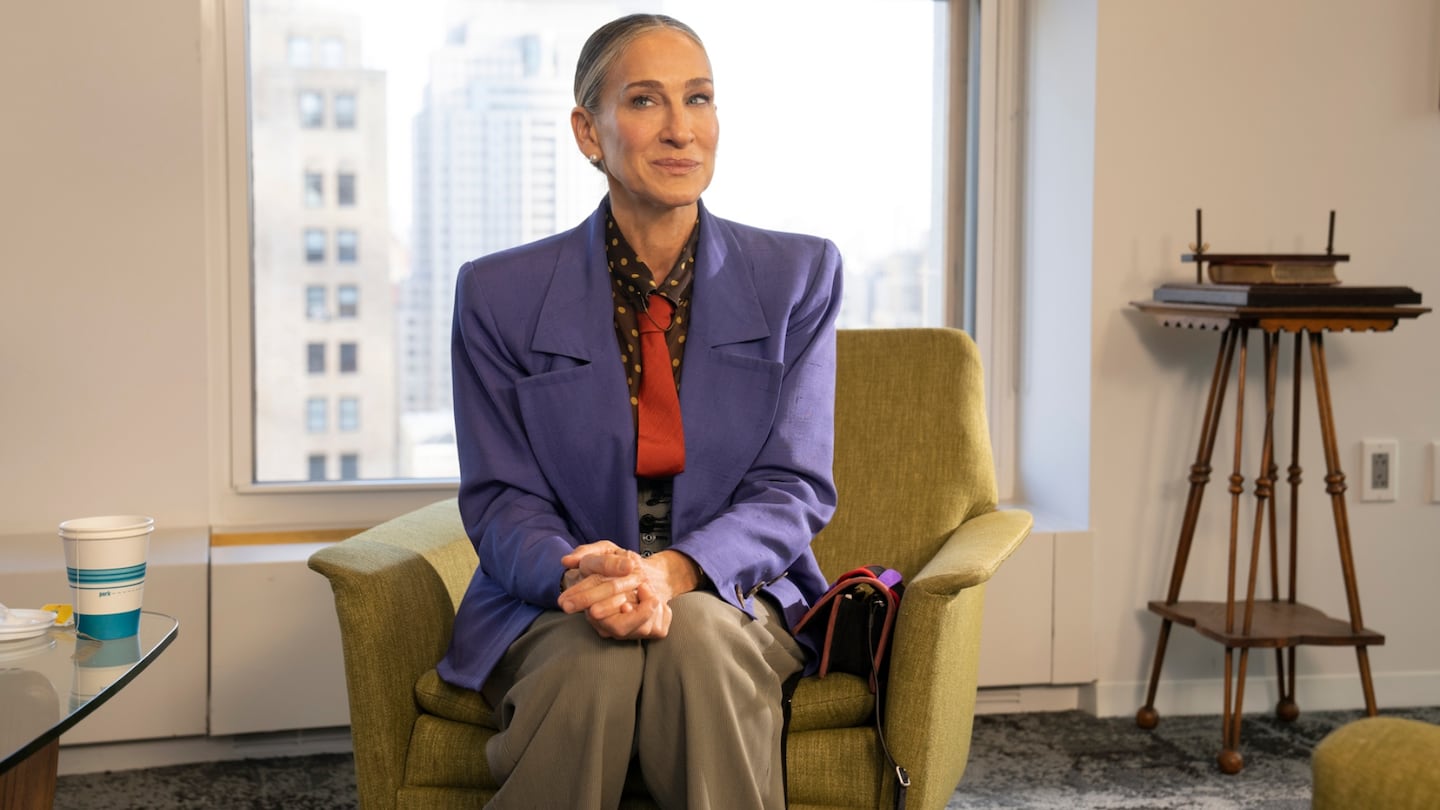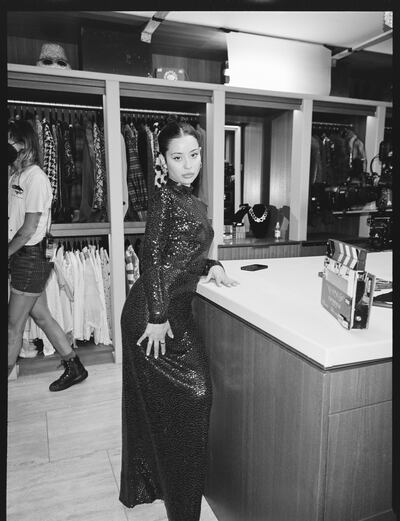
The Business of Fashion
Agenda-setting intelligence, analysis and advice for the global fashion community.

Agenda-setting intelligence, analysis and advice for the global fashion community.

Long before the days of Depop and Etsy, Carrie Bradshaw was a woman looking for a $7 dress to go with her $300 shoes.
As much as Manolo Blahnik heels and Fendi handbags, vintage fashion has been part of “Sex and the City”'s DNA since the series first aired more than two decades ago. So in working on “And Just Like That,” HBO’s reboot, which recently wrapped its first season, costume designers Molly Rogers and Danny Santiago spent nights and weekends scouring Miami vintage stores, Manhattan storage lockers, and dusty attics upstate for the kind of offbeat, wholly original pieces that made Carrie (Sarah Jessica Parker) a style icon back in the late ‘90s.
Sometimes, their choices were polarising — some social media critics compared an ensemble featuring a 1997 Jean Paul Gaultier jumpsuit and a purple blazer to The Joker’s signature look — but never boring. Plus, they reasoned, there was no chance Parker might end up in a “Who Wore It Best?” slideshow next to three other stars in the same piece.
“That’s never going to be [anywhere else] on TV,” said Rogers. “No one would be brave enough to trot around in it.”
ADVERTISEMENT
That jumpsuit may have been quintessentially Carrie, but in recent years, vintage clothing has played a central role in television wardrobes beyond the “Sex and the City” universe. On the most recent season of “Insecure,” Molly (Yvonne Orji) gets robbed at gunpoint in a 1980s one-shoulder dress by Patrick Kelly. On “Euphoria,” teens wear the kind of genuine Y2K pieces their real-world counterparts might order from a resale app. And on “Gossip Girl,” Gen-Z stars carry Fendi Baguettes and Dior Saddle bags — bags that earned their ‘It’ status around the time the cast was born.
Traditionally, costume designers use pieces from decades past to situate a character in a specific era, using hemlines and silhouettes to transport audiences to the midcentury offices of “Mad Men’' or the post-Edwardian drawing rooms of “Downton Abbey.” Today, though, as consumers embrace secondhand in ever-greater numbers, more conscious about clothing’s environmental impact, contemporary shows are turning to vintage to reflect modern style.
The move could be a boon to small business as well as the environment. Hollywood currently spends more than $900 million per year on film and television wardrobes, according to estimates from the Costume Designers Guild. Costume designers and resale companies are forging partnerships beyond New York and Los Angeles to ease the process of sourcing vintage, and are pushing for Hollywood studios and production companies to prioritise secondhand sources when building out clothing budgets.
How Castoffs Became Cool
It wasn’t long ago that secondhand clothing still carried an “ick” factor for many consumers.
“I feel like if Blair Waldorf saw something vintage… she’d hold her nose and turn the other way,” said costume designer Eric Daman, who worked on both 2007′s original “Gossip Girl” and the reboot, which premiered last year. “That was still the era of ‘more is more,’ especially what we were doing on ‘Gossip Girl,’ so [vintage] just didn’t feel nearly as relevant or as important as it does now.”
But for teenagers in 2022, though, shopping secondhand is practically the norm. On the resale app Depop, which was acquired by Etsy last year for $1.6 billion, 90 percent of active users are under age 26. ThredUp, an online thrift store, projects that the global secondhand market will be worth $77 billion by 2025, up from $36 billion in 2021.
In creating this season’s “Euphoria” looks, costume designer Heidi Bivens said she didn’t want viewers to recognise a dress or jacket from the floor at Nordstrom. Instead, the team mined costume rental houses, vintage boutiques, under-the-radar brands, and thrift stores for looks that mashed up eras, transcended current trends and reflected each character’s individuality.
ADVERTISEMENT
“You hope that you’re creating something that feels fresh and surprising so that it’s not derivative of one time or one idea or one decade,” she said of shopping secondhand.
The Opportunity in Vintage
Larger-scale operations are launching to bring vintage and secondhand clothing to Hollywood sets from outside traditional markets.

Last month, the online vintage marketplace Thrilling, in partnership with “Yellowstone” costume designer Ruth E. Carter, announced a new Studio Services programme to connect film and TV professionals with nearly 1,000 vintage shops across the country. Costume designers and stylists outline their needs to a sourcing associate at Thrilling. Then, a bulletin is sent to the stores in Thrilling’s network, who can submit options from both their online and offline inventories. Thrilling then compiles a digital portfolio for the designer or stylist to review and place an order.
“Most costume designers aren’t able to travel that far,” said Shilla Kim-Parker, Thrilling’s co-founder and CEO. “Usually they’re sourcing where the show is shooting. We source from over 200 cities across the US, so we’re able to pull from a much deeper range of inventory than they would physically have access to.”
The initiative also provides secondhand shops with a revenue stream that’s typically only open to businesses in filming hubs like New York and Los Angeles. According to NARTS: The Association of Resale Professionals, there are more than 25,000 resale and consignment shops across the US — more than McDonald’s and Starbucks outposts combined, Kim-Parker points out. The inventory is out there; it just needs to find its way to wardrobe departments.
Vintage also fills a void for costume designers.
“If you want your character to have depth and texture and colour, there are a lot of things that just aren’t being produced anymore,” said Ian Drummond, owner of the Toronto-based vintage rental house the Ian Drummond Collection. “We don’t have those fabric stores anymore where you could go in and buy 10 yards of lamé and make something fantastic.”
ADVERTISEMENT
Even when the resources are there, sometimes vintage makes for the more compelling choice. On “Euphoria,” the character Maddy (Alexa Demie) plays dress-up while babysitting for a wealthy couple, trying on the wife’s collection of archival Halston, Chanel and Thierry Mugler. Bivens originally planned to call in designers for pieces featured in the montage scene, but the looks ended up coming from Brynn Jones, the owner of Aralda Vintage in Los Angeles.
“I thought, ‘Well, maybe this character collects vintage. Because if she collects vintage, then I can do anything,’” said Bivens.
The closet scenes were catnip for Euphoria’s fashion fans; within hours, fan-run Instagram accounts had tracked down the corresponding runway looks and were fawning over the purple Norman Norell gown worn by Samantha (Minka Kelly).
Making Secondhand Work On-Screen
Lending out delicate, one-of-a-kind pieces like those, “I have to really trust the people I’m working with,” said Jones. Costume designers tend to stay away from using vintage for stunts or messy scenes — after all, stains and tears are also a threat to continuity — but with heavy makeup and multiple takes, sometimes accidents happen.
On other occasions, a shot might require an identical garment for a body double, sometimes at the last minute. This past season shooting “Euphoria,” Bivens said that she found herself in need of a vintage kimono. Her supervisor, Devon Patterson, made it happen overnight.
Styling vintage pieces also demands special considerations.
“You have to be very careful when you put vintage on a vintage person,” laughed Rogers. “A fur coat and a snood on a younger girl I think is super fierce. But if you’re older, you might end up looking like you’re in a time warp or something.”
Andrew Bui, the New York City-based vintage dealer that sold Rogers and Santiago the notorious Jean Paul Gaultier jumpsuit (along with several other pieces on the show), said costume designers turn to collections like his for many of the same reasons contemporary fashion designers do.
“The styles that are being created now are basically copies of the past,” he said. “I can say that with conviction because I sell to designers. So why not get the outstanding original?”
Practitioners of this historically behind-the-scenes profession are building powerful followings, riding a wave of interest in how the fashion sausage is made. But even the highest-profile PRs caution that the client still has to comes first.
Join us for a BoF Professional Masterclass that explores the topic in our latest Case Study, “How to Create Cultural Moments on Any Budget.”
When done effectively, a cultural partnership can rightfully earn its own place in the zeitgeist. But it’s not so easy as just hiring a celebrity to star in an ad campaign; brands must choose a partner that makes sense, find the format that fits best and amplify that message to consumers.
Calvin Klein’s chief marketing officer Jonathan Bottomley speaks to Imran Amed about the strategy behind the brand’s buzzy Jeremy Allen White-fronted campaign.